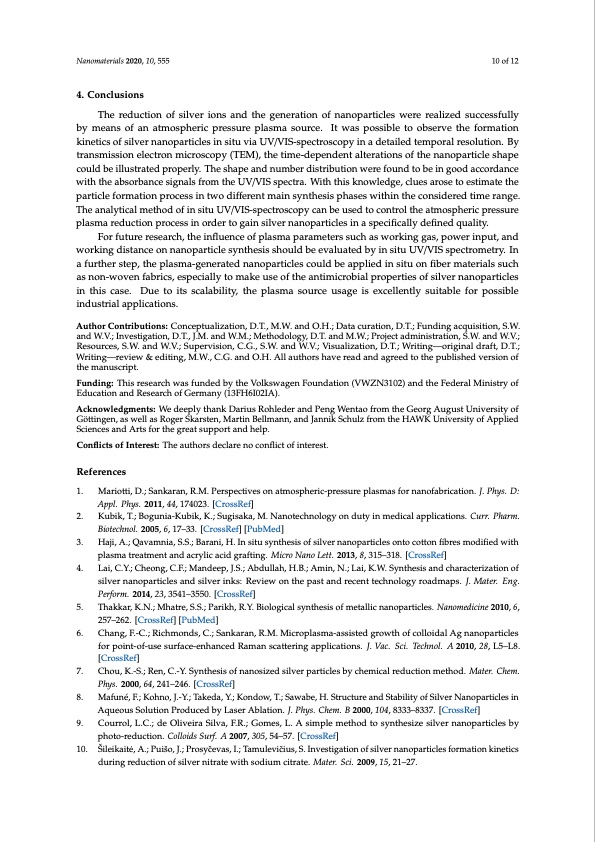
PDF Publication Title:
Text from PDF Page: 010
Nanomaterials 2020, 10, 555 10 of 12 4. Conclusions The reduction of silver ions and the generation of nanoparticles were realized successfully by means of an atmospheric pressure plasma source. It was possible to observe the formation kinetics of silver nanoparticles in situ via UV/VIS-spectroscopy in a detailed temporal resolution. By transmission electron microscopy (TEM), the time-dependent alterations of the nanoparticle shape could be illustrated properly. The shape and number distribution were found to be in good accordance with the absorbance signals from the UV/VIS spectra. With this knowledge, clues arose to estimate the particle formation process in two different main synthesis phases within the considered time range. The analytical method of in situ UV/VIS-spectroscopy can be used to control the atmospheric pressure plasma reduction process in order to gain silver nanoparticles in a specifically defined quality. For future research, the influence of plasma parameters such as working gas, power input, and working distance on nanoparticle synthesis should be evaluated by in situ UV/VIS spectrometry. In a further step, the plasma-generated nanoparticles could be applied in situ on fiber materials such as non-woven fabrics, especially to make use of the antimicrobial properties of silver nanoparticles in this case. Due to its scalability, the plasma source usage is excellently suitable for possible industrial applications. Author Contributions: Conceptualization, D.T., M.W. and O.H.; Data curation, D.T.; Funding acquisition, S.W. and W.V.; Investigation, D.T., J.M. and W.M.; Methodology, D.T. and M.W.; Project administration, S.W. and W.V.; Resources, S.W. and W.V.; Supervision, C.G., S.W. and W.V.; Visualization, D.T.; Writing—original draft, D.T.; Writing—review & editing, M.W., C.G. and O.H. All authors have read and agreed to the published version of the manuscript. Funding: This research was funded by the Volkswagen Foundation (VWZN3102) and the Federal Ministry of Education and Research of Germany (13FH6I02IA). Acknowledgments: We deeply thank Darius Rohleder and Peng Wentao from the Georg August University of Göttingen, as well as Roger Skarsten, Martin Bellmann, and Jannik Schulz from the HAWK University of Applied Sciences and Arts for the great support and help. Conflicts of Interest: The authors declare no conflict of interest. References 1. Mariotti, D.; Sankaran, R.M. Perspectives on atmospheric-pressure plasmas for nanofabrication. J. Phys. D: Appl. Phys. 2011, 44, 174023. [CrossRef] 2. Kubik, T.; Bogunia-Kubik, K.; Sugisaka, M. Nanotechnology on duty in medical applications. Curr. Pharm. Biotechnol. 2005, 6, 17–33. [CrossRef] [PubMed] 3. Haji, A.; Qavamnia, S.S.; Barani, H. In situ synthesis of silver nanoparticles onto cotton fibres modified with plasma treatment and acrylic acid grafting. Micro Nano Lett. 2013, 8, 315–318. [CrossRef] 4. Lai, C.Y.; Cheong, C.F.; Mandeep, J.S.; Abdullah, H.B.; Amin, N.; Lai, K.W. Synthesis and characterization of silver nanoparticles and silver inks: Review on the past and recent technology roadmaps. J. Mater. Eng. Perform. 2014, 23, 3541–3550. [CrossRef] 5. Thakkar, K.N.; Mhatre, S.S.; Parikh, R.Y. Biological synthesis of metallic nanoparticles. Nanomedicine 2010, 6, 257–262. [CrossRef] [PubMed] 6. Chang, F.-C.; Richmonds, C.; Sankaran, R.M. Microplasma-assisted growth of colloidal Ag nanoparticles for point-of-use surface-enhanced Raman scattering applications. J. Vac. Sci. Technol. A 2010, 28, L5–L8. [CrossRef] 7. Chou, K.-S.; Ren, C.-Y. Synthesis of nanosized silver particles by chemical reduction method. Mater. Chem. Phys. 2000, 64, 241–246. [CrossRef] 8. Mafuné, F.; Kohno, J.-Y.; Takeda, Y.; Kondow, T.; Sawabe, H. Structure and Stability of Silver Nanoparticles in Aqueous Solution Produced by Laser Ablation. J. Phys. Chem. B 2000, 104, 8333–8337. [CrossRef] 9. Courrol, L.C.; de Oliveira Silva, F.R.; Gomes, L. A simple method to synthesize silver nanoparticles by photo-reduction. Colloids Surf. A 2007, 305, 54–57. [CrossRef] 10. Šileikaite ̇, A.; Puišo, J.; Prosycˇevas, I.; Tamulevicˇius, S. Investigation of silver nanoparticles formation kinetics during reduction of silver nitrate with sodium citrate. Mater. Sci. 2009, 15, 21–27.PDF Image | Formation Kinematics of Plasma-Generated Silver Nanoparticles

PDF Search Title:
Formation Kinematics of Plasma-Generated Silver NanoparticlesOriginal File Name Searched:
nanomaterials-10-00555-v2.pdfDIY PDF Search: Google It | Yahoo | Bing
Turbine and System Plans CAD CAM: Special for this month, any plans are $10,000 for complete Cad/Cam blueprints. License is for one build. Try before you buy a production license. More Info
Waste Heat Power Technology: Organic Rankine Cycle uses waste heat to make electricity, shaft horsepower and cooling. More Info
All Turbine and System Products: Infinity Turbine ORD systems, turbine generator sets, build plans and more to use your waste heat from 30C to 100C. More Info
CO2 Phase Change Demonstrator: CO2 goes supercritical at 30 C. This is a experimental platform which you can use to demonstrate phase change with low heat. Includes integration area for small CO2 turbine, static generator, and more. This can also be used for a GTL Gas to Liquids experimental platform. More Info
Introducing the Infinity Turbine Products Infinity Turbine develops and builds systems for making power from waste heat. It also is working on innovative strategies for storing, making, and deploying energy. More Info
Need Strategy? Use our Consulting and analyst services Infinity Turbine LLC is pleased to announce its consulting and analyst services. We have worked in the renewable energy industry as a researcher, developing sales and markets, along with may inventions and innovations. More Info
Made in USA with Global Energy Millennial Web Engine These pages were made with the Global Energy Web PDF Engine using Filemaker (Claris) software.
Infinity Turbine Developing Spinning Disc Reactor SDR or Spinning Disc Reactors reduce processing time for liquid production of Silver Nanoparticles.
| CONTACT TEL: 608-238-6001 Email: greg@infinityturbine.com | RSS | AMP |